Is NASA's $2.5 billion Mars rover doomed?
Ten years of work by 1,000 people, and the thing might not even launch. Inside the technical and financial problems plaguing the nuclear-powered Curiosity rover

NASA's next Mars rover, a nuclear-powered marvel nicknamed Curiosity, is supposed to blast off for the Red Planet later this year. But an audit issued this week by the space agency's inspector general finds a host of unresolved issues that could put the mission in jeopardy. Here, a brief guide to the mess:
What makes this rover so special?
It's "the most ambitious Mars project NASA has ever mounted," says Michelle Norris at NPR. Officially, the rover is called Mars Science Laboratory (MSL), but it's more commonly known as Curiosity. A nuclear-powered, car-sized vehicle, Curiosity is "the product of almost 10 years of work by 1,000 people," says Eryn Brown in the Los Angeles Times. Weighing four times as much as previous models (Spirit and Opportunity), it can drive long distances over rough terrain, and uses an unprecedented array of instruments to hunt for Martian life, says Lisa Grossman at Wired.
The Week
Escape your echo chamber. Get the facts behind the news, plus analysis from multiple perspectives.

Sign up for The Week's Free Newsletters
From our morning news briefing to a weekly Good News Newsletter, get the best of The Week delivered directly to your inbox.
From our morning news briefing to a weekly Good News Newsletter, get the best of The Week delivered directly to your inbox.
And what is it supposed to do on Mars?
The plan is to lower Curiosity onto the planet from a hovercraft, using what NASA calls a "sky-crane" system. Once on the surface, Curiosity is supposed to "use a robotic arm and a suite of 10 instruments to survey an area as large as 20 km (12 mi.) across for evidence of current and past habitability," says Frank Morring, Jr. at AviationWeek.
So what's the problem?
Though the (repeatedly delayed) Curiosity is nearly ready to launch in November or December, two key software issues remain and NASA expects it will have to use a $22 million reserve fund to get things done in time. Development costs have already jumped from $969 million to $1.8 billion, with total mission costs of $2.5 billion.
A free daily email with the biggest news stories of the day – and the best features from TheWeek.com
What would happen if NASA misses its launch window?
"Because Earth and Mars only line up once every two years, NASA would have to wait until 2013" to try again, says says Grossman at Wired. That delay would cost another $570 million. If the agency failed to line up the extra funding, the project may have to be scrapped. NASA's project managers admit they are cutting it close, but insist they'll finish in time. "Still, we’re uncomfortably reminded of a nervous joke among Mars exploration scientists," says Grossman: "On time, on budget, on Mars: Pick two."
Sources: AviationWeek, Los Angeles Times, NPR, Wired
-
 Political cartoons for January 4
Political cartoons for January 4Cartoons Sunday's political cartoons include a resolution to learn a new language, and new names in Hades and on battleships
-
 The ultimate films of 2025 by genre
The ultimate films of 2025 by genreThe Week Recommends From comedies to thrillers, documentaries to animations, 2025 featured some unforgettable film moments
-
 Political cartoons for January 3
Political cartoons for January 3Cartoons Saturday's political cartoons include citizen journalists, self-reflective AI, and Donald Trump's transparency